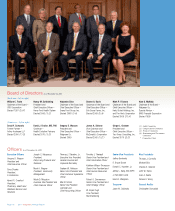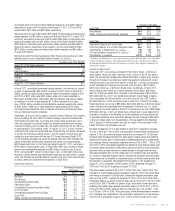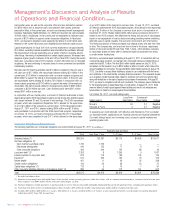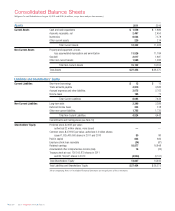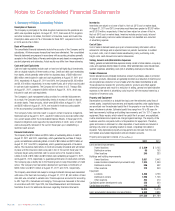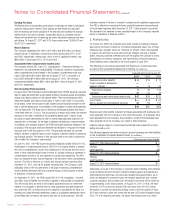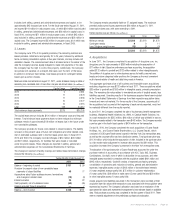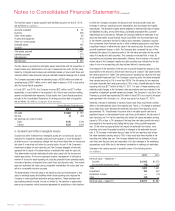Walgreens 2011 Annual Report Download - page 25
Download and view the complete annual report
Please find page 25 of the 2011 Walgreens annual report below. You can navigate through the pages in the report by either clicking on the pages listed below, or by using the keyword search tool below to find specific information within the annual report.
The expected timing of payments of the obligations above is estimated based on
current information. Timing of payments and actual amounts paid may be different,
depending on the time of receipt of goods or services, or changes to agreed-upon
amounts for some obligations.
Off-Balance Sheet Arrangements
We do not have any unconsolidated special purpose entities and, except as
described herein, we do not have significant exposure to any off-balance sheet
arrangements. The term “off-balance sheet arrangement” generally means any
transaction, agreement or other contractual arrangement to which an entity uncon-
solidated with us is a party, under which we have: (i) any obligation arising under
a guarantee contract, derivative instrument or variable interest; or (ii) a retained
or contingent interest in assets transferred to such entity or similar arrangement
that serves as credit, liquidity or market risk support for such assets.
Letters of credit are issued to support purchase obligations and commitments
(as reflected on the Contractual Obligations and Commitments table) as follows
(In millions):
Inventory obligations $ 143
Insurance 40
Real estate development 13
Total $ 196
In addition to issued letters of credit, we held $191 million of restricted cash to
support certain insurance obligations at August 31, 2011. In fiscal year 2010,
our insurance obligations were supported by letters of credit, some of which were
subsequently released in the current fiscal year upon establishing a restricted
cash account.
We have no off-balance sheet arrangements other than those disclosed on the
Contractual Obligations and Commitments table. Both on-balance sheet and
off-balance sheet financing alternatives are considered when pursuing our capital
structure and capital allocation objectives.
Recent Accounting Pronouncements
In August 2010, the Financial Accounting Standards Board (FASB) issued an exposure
draft on lease accounting that would require entities to recognize assets and liabilities
arising from lease contracts on the balance sheet. The proposed exposure draft
states that lessees and lessors should apply a “right-of-use model” in accounting
for all leases. Under the proposed model, lessees would recognize an asset for the
right to use the leased asset, and a liability for the obligation to make rental payments
over the lease term. The lease term is defined as the longest possible term that is
“more likely than not” to occur. The accounting by a lessor would reflect its
retained exposure to the risks or benefits of the underlying leased asset. A lessor
would recognize an asset representing its right to receive lease payments based on
the expected term of the lease. On the basis of feedback received from comment
letters, roundtables, and outreach sessions, the FASB has made significant changes
to the proposals in the exposure draft and therefore has decided to re-expose the
revised exposure draft in the first quarter of 2012. The proposed standard, as currently
drafted, will have a material impact on the Company’s reported results of operations
and financial position. The impact of this exposure draft is non-cash in nature
and will not affect the Company’s cash position.
On June 16, 2011, the FASB issued Accounting Standards Update (ASU) 2011-05,
Presentation of Comprehensive Income. ASU 2011-05 requires entities to present the
total of comprehensive income, the components of net income and the components
of other comprehensive income in either (1) a single continuous statement of
comprehensive income or (2) two separate but consecutive statements. The ASU
does not change the items that are required to be reported in other comprehensive
income. The ASU is effective for interim and annual periods beginning after
December 15, 2011, and will be applied retrospectively. The Company is still
evaluating which of the two alternatives it will apply in reporting comprehensive
income. Neither alternative will have a material impact on the Company’s results
of operations or financial position.
On September 15, 2011, the FASB issued ASU 2011-08, Intangibles – Goodwill
and Other, which simplifies how an entity is required to test goodwill for impairment.
This ASU would allow an entity to first assess qualitative factors to determine
whether it is necessary to perform the two-step quantitative goodwill impairment
test. Under the ASU, an entity would not be required to calculate the fair value of a
reporting unit unless the entity determines, based on a qualitative assessment, that
it is more likely than not that its fair value is less than its carrying amount. The ASU
includes a number of factors to consider in conducting the qualitative assessment.
The ASU is effective for annual and interim goodwill impairment tests performed
for fiscal years beginning after December 15, 2011. Early adoption is permitted.
This standard is not expected to have a material impact on the Company’s reported
results of operations or financial position.
Cautionary Note Regarding Forward-Looking Statements
This report and other documents that we file or furnish with the Securities and
Exchange Commission contain forward-looking statements that are based on current
expectations, estimates, forecasts and projections about our future performance, our
business, our beliefs and our management’s assumptions. Statements that are not
historical facts are forward-looking statements, including forward-looking information
concerning pharmacy sales trends, prescription margins, number and location of new
store openings, vendor, payer and customer relationships and terms, possible new
contracts or contract extensions, competition, economic and business conditions,
outcomes of litigation and regulatory matters, the level of capital expenditures, industry
trends, demographic trends, growth strategies, financial results, cost reduction
initiatives, acquisition synergies, competitive strengths and changes in legislation
or regulations. Words such as “expect,” “likely,” “outlook,” “forecast,” “would,”
“could,” “should,” “can,” “will,” “project,” “intend,” “plan,” “continue,” “sustain,”
“on track,” “believe,” “seek,” “estimate,” “anticipate,” “may,” “possible,” “assume,”
variations of such words and similar expressions are intended to identify such forward-
looking statements, which are made pursuant to the safe harbor provisions of the
Private Securities Litigation Reform Act of 1995. These forward-looking statements are
not guarantees of future performance and involve risks, assumptions and uncertainties,
including, but not limited to, those relating to changes in vendor, payer and customer
relationships and terms, competition, changes in economic and business conditions
generally or in the markets we serve, risks associated with new business initiatives and
activities, the failure to obtain new contracts or extensions of existing contracts, the
availability and cost of real estate and construction, risks associated with acquisitions
and divestitures, the ability to realize anticipated results from capital expenditures and
cost reduction initiatives, outcomes of legal and regulatory matters, changes in
legislation or regulations or interpretations thereof, and those described in Item
1A “Risk Factors” in our Form 10-K and in other reports that we file or furnish
with the Securities and Exchange Commission. Should one or more of these risks
or uncertainties materialize, or should underlying assumptions prove incorrect, actual
results may vary materially from those indicated or anticipated by such forward-looking
statements. Accordingly, you are cautioned not to place undue reliance on these
forward-looking statements, which speak only as of the date they are made. Except
to the extent required by law, we do not undertake, and expressly disclaim, any duty
or obligation to update publicly any forward-looking statement after the date the
statement is made, whether as a result of new information, future events, changes in
assumptions or otherwise.
2011 Walgreens Annual Report Page 23





